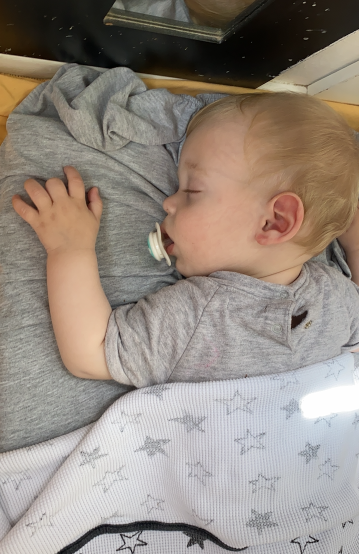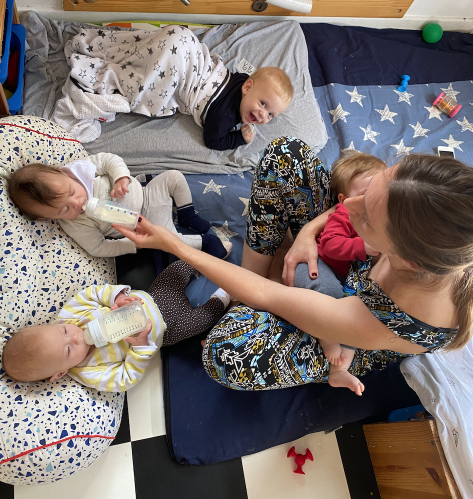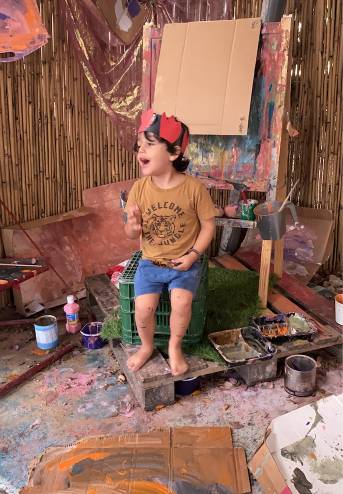According to the British Association of Day Nurseries:
Daytime naps are crucial for babies and young children’s’ brain development and are essential for their wellbeing. Yet many young children go without a sufficient nap at nursery,  either because it does not have a dedicated sleep area or because the parent has specifically asked for their children’s sleep to be limited, or for them not to be given a nap. This is unhealthy and not in the best interests of the child’s wellbeing
either because it does not have a dedicated sleep area or because the parent has specifically asked for their children’s sleep to be limited, or for them not to be given a nap. This is unhealthy and not in the best interests of the child’s wellbeing
At Rainbow, we want to do all we can to ensure that children are physically healthy and have basic needs met such as sufficient sleep and rest during nursery day. Sometimes this may be in contrast to what parents believe is most convenient for helping with an earlier bedtime at home. Our responsibility is to the child in our care, and to be committed to working with the family to allow all children to have access to the sleep and rest they need during the busy and tiring nursery day.
Children will often give up their naps at the weekend long before they should give up their naps in nursery; this is because the nursery day is usually much more physically and mentally (intellectually) demanding than a day spent at home, or with family. At nursery their are many play and learning opportunities on offer, often simultaneously and the children’s day can be very busy, both before and after sleep time. Children need to be well rested in order to fully and safely take part in the full range of learning experiences on offer at the nursery.
Rainbow’s sleep policy:
 Babies, which include children under 9 months will usually sleep every 3 – 4 hours, and on demand or following sleeping patterns during the day which have been discussed and agreed with parents
Babies, which include children under 9 months will usually sleep every 3 – 4 hours, and on demand or following sleeping patterns during the day which have been discussed and agreed with parents
A specific sleep area in the classroom is identified, and children younger that 9 months will generally sleep when they need to, regardless of the classroom routines. Provision will always be made to support babies sleep.
As children grow older, and move beyond 9 months their sleeping patterns tend to begin to fall into a more traditional routine.
From around 9 months, until 15 – 18 months (depending on the child) children will have a ‘morning sleep’; this will usually be for up to 45 minutes, from approximately 8:30-8:45. Children will then sleep again after their lunch, for a longer and more significant sleep, which may be up to 3 hours. This is usually from 11:45-12:00.
As children get older, their morning sleep will be dropped, but the afternoon sleep will remain, and might initially be longer, and as they get older it will naturally shorten.
The day at Rainbow is busy, and children require focus and attention in the afternoon, in equal amounts to the morning. So, it is important that they are well rested, and not tired so that they can properly focus, take part in activities and learning experiences safely. Tired children are more likely to have accidents in the afternoons, trip over and engage in conflict with other children. This is why we require all children under 4 years old to rest after lunch.
We expect children in Pandas, Crocodiles and Armadillos to sleep for between 45 minutes and no longer than 3 hours after their lunch. Many children in Leopards will also fall asleep, but all children in this class will have a minimum of 30 minute rest time laying on their beds quietly. We will not prevent any children in these groups from sleeping.
We allow all children age 2 and below to sleep as long as they wish. If they sleep for more  than 3 hours, we will gently wake them up, otherwise it is Rainbow policy in line with best practice in early years to allow children to sleep as they need too whilst in nursery.
than 3 hours, we will gently wake them up, otherwise it is Rainbow policy in line with best practice in early years to allow children to sleep as they need too whilst in nursery.
For children aged 2 to 2.5 years we will not wake children up before 2 hours of sleep and only if requested. And, for children aged 2.5 and above years we will not wake children up before 1.5 hours of sleep and only if requested.
Their sleep needs and times may also change with the season, for example in the very hot whether children will become more tired and irritable and will rely more heavily on good quality sleep, to function properly in the afternoon.
If children have not fallen asleep within 30 minutes of being on their beds, they can choose to get up and play either in designated spaces within the classroom or in the garden or a shared area of the nursery building, as per the class timetable; or to remain on their bed as long as they wish.
 The children in Giraffes will not have a designated sleep time, but there are opportunities during the day to take part in quieter and more relaxing sedimentary activities. There is
The children in Giraffes will not have a designated sleep time, but there are opportunities during the day to take part in quieter and more relaxing sedimentary activities. There is
also a rest area in the classroom, so that children can retire for a rest if they wish. If children are tired, and need to sleep on a specific day, they will have the opportunity to join the Armadillos or Leopards class for a dedicated sleep.
As part of our policy, the following Sleep-time procedures will be followed by staff:
Children will:
- Sleep in clean and dry clothes
- Wear a nappy for sleep if required
- Use a dummy that they have brought from home if this helps them sleep
- Sleep on their own dedicated mattress with sheets and a blanket from home
- Use a sleep time ’toys’ or comfort object if they have brought one from home. These are kept in the nursery, in a special ‘sleep time’ box, and should not travel back and forth with children daily
The sleep environment will include:
- Classical ’sleep time’ relaxation music will play in sleep rooms during designated sleep-time periods
- Staff on duty, and in the sleep room/s at all times whilst children are asleep
- A controlled and cool temperature of between 16 oC and 20 oC
- Lightweight blankets may be used
- Pillows will not be used or available for children during sleeptime
- Staff record the time each child fell asleep and when they woke up, these records are available to parents
Sleeping routines:
- Children under 9 months will always be placed on their back to sleep, however if they turn, it is our policy not to turn them back, but to monitor the child carefully
- Children who find it difficult to fall asleep in the nursery, or to stay in their beds will have support from a staff member, who will gently pat their back as they lay in their beds, this will usually help them sleep. The staff support will reduce over time to encourage independence
- The designated sleep areas are always within a main play space, as their are no dedicated sleep-only rooms at Rainbow
- As children begin to wake from their naps, they are able to leave their beds as soon as they are ready. The older children will often help with putting their mattress away, the staff do this for the children in the younger groups, and the play spaces is quickly re-formed with learning materials and play resources put out to choose from
- After the first hour to 90 minutes of sleep time, slowly the room will start being reset, and children who are awake will play around the sleeping children, and/or in other designed parts of the classroom or nursery
Background to the policy:
What is sleep?
During sleep, some parts of the brain quieten – like the pre-frontal cortex, which underlies attention, working memory and planning (all we as humans need to navigate our complex world). However, other parts of the brain wake up – like the midbrain, which acts as a relay station for visual and auditory information.
Sleep helps us to organise the information of the day, allowing for better memory retrieval later. And that means sleep actively moderates learning and development. So, telling someone to get a good night’s sleep before a big test is not just about being alert during the test; it actually will support better memory of the studied subjects.
Throughout a night’s sleep, our brains move through a series of stages during which brain waves slow down. This period of slow wave sleep is accompanied by relaxation of the entire body. Heart rate, blood pressure and body temperature all fall. It is this stage that most people think about when they think about sleep – the relaxation, the unconscious state. After these stages, however, brain activity changes radically, from that deep slow wave sleep to rapid eye movement (REM) sleep, which is when active dreaming occurs.
This stage is characterised by brain waves that are startlingly similar to those observed during waking. The younger you are, the more time you spend in REM sleep. Given that infancy and childhood is a critical time in learning, there is a strong suggestion that the brain activity occurring during REM sleep may be important for actual physical brain  development. In other words, a child’s brain actually changes during sleep.
development. In other words, a child’s brain actually changes during sleep.
How do young children sleep?
Throughout early and middle childhood, sleep patterns become more consistent and stable, similar to those of adults. Yet, in early childhood (from one to five years) children continue to need a sleep cycle that is comprised of multiple naps during the day and an extended period of sleep at night.
According to the UK national guidelines; young children need on average ten to 12 hours of sleep, including at least a one hour nap. The United States National Sleep Foundation states that three- to five-year-olds should sleep 11 to 13 hours.
Although sleep requirements do vary across individuals, these guidelines are based on many scientific research programmes across the domains of paediatrics and child psychology. They can, therefore, definitely help us figure out whether children are getting the sleep they need in order to function at their best in both school and social situations.
Some new research has suggested that the light emanating from screens can actually turn off the sleep hormone (melatonin). This is clearly not a good thing for a child with sleep issues.
How much sleep should children have?
Below are the optimal sleep requirements for children aged from four months to 18 years, as set out by the American Academy Of Sleep Medicine (2016)…
- Infants aged 4 to 12 months: 12–16 hours of sleep (including naps)
- Children aged 1 to 2 years: 11–14 hours (including naps)
- Children aged 3 to 5 years: 10–13 hours (including naps)
- Children aged 6 to 12 years: 9–12 hours
- Teenagers aged 13 to 18 years: 8–10 hours
Where parents are concerned that sleeping at Nursery is having a negative impact on sleeping at night
The manager will meet with parents to discuss any concerns that they have over their child’s sleep patterns and routines, especially those relating to the time at nursery.
It is a fact, that if a child sleeps during the day, and is well rested, then they are much more likely to have a restful night’s sleep than if they have been kept awake during the day, without the opportunity to properly rest and sleep.
Some parents believe that by limiting or cutting out daytime naps, their children will go to bed earlier at night. This is not true. The child’s bedtime routine and what happens in the two hours leading up to bedtime has a much bigger impact on how ready and settled your child is for their night sleep.
Children should not have access to any screens for ideally 2 hours, but at least 1 hour prior to sleep. This includes iPads, tablets, computers, TVs, games consoles and all other screens and electronic devises. This is because such devises ‘wake’ children’s brains, and the colours, images and sounds can suppress melanin, which is the chemical released by the brain to tell children (people) that it’s time to sleep! A good, healthy and repetitive nightly routine will also encourage positive bedtime behaviour and a smooth transition from the day to the night-time sleep.
Here are some of the common reasons why children may resist sleep or going to bed in the evening:
- They don’t want to be by themselves.
- They don’t want to miss out on any activity.
- They are too excited, restless or anxious and can’t relax.
- Their routine is not consistent, and change from one day to the next
- They are hungry or thirsty, or have some other physical discomfort.
- They have been over-stimulated, too close to bed time
- They have eaten high sugar or high energy foods shortly before bedtime, which prevents their bodies from winding down
When children sleep during the day, and are well rested, this helps with the bedtime routine, it doesn’t make it harder.
The bedtime routine is the foundation for a good night’s sleep. Get this right and sleep onset should be easy. It includes what is happening in the hour before falling asleep with positive sleep associations.
Sleep associations are cues and triggers that children need to have to help them fall asleep. Sleep problems can occur when the association cannot be maintained throughout the night and the child wakes and cannot fall back to sleep. Common sleep associations are a special toy to cuddle, a dummy or parent who stays with the child until they fall asleep.
When a child wakes in the night (we all wake around two or three times each night naturally) and finds the sleep association is no longer there, they are more likely to become fully awake and need help to go back to sleep. Learning to self-settle can be tricky, but with the support of early years professionals it can become easier. Teaching children about good bedtime routines and sleep associations can empower them to choose healthy sleeping habits.
Below is an example of a good bedtime routine that should help children to fall asleep.
Eating the evening meal together as a family.
Quiet time in the evening – no TV, phones or tablets for at least an hour before bed, as this reduces production of melatonin, the hormone that helps us fall asleep.
- Bath or wash time.
- Story time in the bedroom, with low lights and curtains closed.
- Snuggled into bed with a favourite toy.
- A kiss goodnight.
- Lights out.
Discussing time, clocks and numbers offers an ideal opportunity to talk about nap/bedtimes and wake-up times in your setting and at home. Bedtime should be the same each night – it is also important to get up at the same time each day, to anchor and reset the body clock. Late nights and lie-ins can quickly lead to problems.
Further reading, and references used within this sleep policy statement:
https://www.teachearlyyears.com/a-unique-child/view/easy-ways-to-encourage-healthy-sleep-in-nursery
